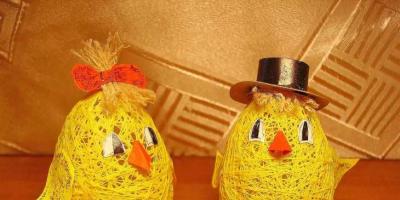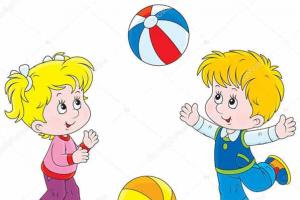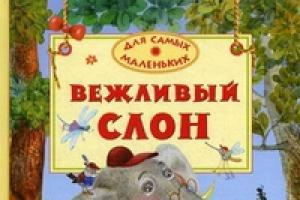SCENARIO OF THE HOLIDAY “WORLD WELCOME DAY”
Tasks:
1. Introduce children to the international holiday - Greetings Day;
2. Contribute to the development in students of empathy, kindness, politeness and attentive attitude towards others;
3. Strengthen children’s ability to work in a team.
Progress of the event
Invented by someone simply and wisely
When meeting, greet: “Good morning! »
"Good morning! » to the sun and birds!
"Good morning! "Smiling faces!
And everyone becomes kind, trusting...
Let “Good morning! "lasts until the evening!
Good afternoon, dear children and adults! Show presentation: On November 21, the entire planet celebrates World Greetings Day - “Hallow Day”. It was invented by the Americans McCormick brothers in 1973, as a protest against increasing international tension and the Cold War. On this day, everyone who wants friendship, peace and harmony between people all over the planet should say hello to at least ten strangers, write a friendly letter to their peers living in another city or country.
Let us also say to each other: “Hello!” But let's do it in a different way than usual. . When I say: "Hello!" - All the boys will shout: “Fireworks!” - and wave to me. Let's try. Hello!
Boys greetings.
Girls, I suggest you say hello in French, like this: “Bonjour!” - and blow me a kiss. So, let's rehearse. Hello!
The girls are greeted.
Dear adults, our teachers, say hello to me in Eastern style. To do this, you need to fold your palms in front of your chest, make a small bow and say: “Salaam alaikum!” Hello!
Together: Now say hello to me, boys, girls, and adults.
Ved: How many peoples - so many greetings! Every nation has its own custom of greeting. So, how do people say hello in different countries? Attention to the screen: showing the presentation
For example, Belarusians ? (Good zen) Let's say hello like Belarusians ! (all: Good Zen) And in Ukrainian ? (Good day) And now, like the Ukrainians! (all: Good Day) And the ancient Greeks when they saw each other they said to each other “Khaire! ”, which is translated into Russian: “Rejoice! "Let's greet each other like the ancient Greeks! (all: Khaire) Americans When meeting, they shake each other's right hand. Shake hands! (shake hands) In New Zealand indigenous people greet each other by rubbing noses. Latin Americans - hugging. IN Brazil - pat each other on the shoulder. In Zimbabwe, local residents - Africans - rub their backs. Japanese - they put their palms together and bow (shows) (everyone greets like the Japanese) and the residents of the distant countries Singapore put their right hand on their heart to show goodwill towards the interlocutor (shows). Some Indian tribes When you see a stranger, it is customary to squat down until he approaches you. Some tribes remove their shoes to greet people. Tibetans, when greeting, they take off their headdress with their right hand, put their left hand behind their ear and stick out their tongue (they greet like Tibetans).
We said hello, great, now let's have some great fun!
We will sing, joke, dance and, of course, play!
Runs out Absent-minded
Leading: Oh, who are you?
Absent-minded
My name is Absent-minded,
There is not a day without adventure:
I confuse everything, I lose everything,
I always forget everything...
Oh, my bitter fate!
Leading:
How did you come to us, where did you come from?
Absent-minded
I came to you with greetings.
Leading: Well, where is hello then? Come on, the guys are waiting!
Absent-minded
Yes, I don’t have it (cries)
Your school brownie “Nafanya” took it from me and hid it.
Leading: Where did you hide it?
Scattered: Yes, you need to ask him!
Runs out Nafanya(To music)
Leading: Hello dear. What should I call you?
Nafanya: I won't talk! I'm offended
Leading: But on who?
Nafanya: On the Absent-Minded One, he doesn’t know how to say hello. And your children are also ill-mannered, they didn’t say hello to me either. Moreover, on such a day - Welcome Day.
Scattered: Just think... I forgot, I was rushing to greet the guys! Well, please forgive me, Nafanechka.
Nafanya: Okay, but since you did something wrong, you and the guys should now play the game “Find Hello” with me, and the guys will help you.
Leading: What, guys, can we help return our greetings to the Scattered One?
Nafanya: In order to return hello, you need to go through the stages and complete tasks. If the guys successfully complete the tasks at the stages, they will receive your greetings.
Leading: Guys, do you agree?
Route sheets are distributed by class, points are not given on the route sheets, but words are given out; if the group completed the task at the stage correctly, then they are given the whole word, if not, then they receive part of it.
Children run through the stages together with their teachers.
After they run, they return to the assembly hall, where the final stage will take place, the results are summed up and sweet prizes are distributed, which are greetings from the Absent-Minded One.
Leading:
Despite the bad weather in November
Today, my friend, smile
And tell the stranger passing by:
“Good afternoon” and share your warmth!
Let the birds greet you today
They will fly from you and to you!
And from this, maybe later
There will be more goodness on earth!
Stage tasks
Stage "RITUAL OF WELCOME"
Host: Hello my friends,
I'm glad to see you!
Let me hug you,
I wish you all good luck.
Guys, with these words I greet my students every day at the “School of Polite Sciences.” What traditions and rituals of greetings in poetry do you know?
Each class demonstrates its own greeting ritual.
Game: “Greetings!”
Children stand in a circle. A child is called into the middle of the circle and is blindfolded. Children standing in a circle greet him if they wish. The person standing in the circle must guess and name the name of the person who greeted him
Option: Welcome Ritual Hello, Heaven!
(Raise your hands up)
Hello, Sun!
(Make a large circle with your hands above your head)
Hello Earth!
(Smoothly lower your hands to the carpet)
Hello, our big family!
(All the guys hold hands and raise them up)
All the children gathered in a circle,
I am your friend and you are my friend.
Let's hold hands together
And let's smile at each other! (Hold hands and look at each other with a smile).
"Discussion" stage
Leading: Friends, here you go just in case
A story about a boy...
His name is...but it’s better
We won't name him here.
“Thank you”, “hello”, “sorry”
- He’s not used to pronouncing
A simple word “sorry”
His tongue did not overcome him.
He is often lazy
Say “Good afternoon” when meeting.
It would seem a simple word,
And he is shy, silent,
And at best “great”
Instead of saying “hello,” he says.
And instead of the word “goodbye”
He doesn't say anything.
Or he will say goodbye:
“Well, I'm off, bye, that's all. . . ”
Tell me, what words does the hero of this poem use when meeting and saying goodbye? (Great, bye)
What words of greeting do you use when greeting adults and peers?
Who can you greet with “great” and “hello”? (his friends)
Who will you say goodbye to?
Can this boy be called polite and well-mannered?
Game "This is very good (bad)"
Leading. : How were the guys brought up? We need to find out today!
I’m humming a line for you, and I’m waiting for your answer!
(answer one by one)
1. We got together today (this is very good) - boys
2. And today laughter is appropriate! (this is very good) - girls
3. We will sing and dance (this is very good) -m
4. And offend girls! (this is very bad) - d
5. We say “Thank you” to everyone! (this is very good) m
6. You could have been polite! (this is very good) d
7. But boys are naughty! (this is very bad) m
8. They wear torn pants! (this is very bad) - d
9. We take new toys! (this is very good) m
10. We will break and tear everything! (this is very bad) -d
11. Let's give kindness! (this is very good) -m
12. We will whine and mope! (this is very bad) – d
13. Don't tease or be rude! (this is very good) m
14. The word “Hello! " speak! (this is very good) – d
15. Don’t offend anyone! (this is very good) -m
16. Everyone respect each other! (this is very good) -d
3. stage “IN THE WORLD OF ANIMALS”
Leading: Guys, do you know that the animal world cannot do without greetings?
- Dogs greet by barking and wagging their tails.
Children pretend
- When lynxes meet, they perform a greeting ritual by sniffing each other’s noses. They stand opposite and begin to butt heads so hard that a bone sound is heard.
Children pretend
Storks begin to crack their beaks when they meet.
Children pretend
Giant African snails recognize their owner's voice by intonation and whistle joyfully in response to a greeting.
Children pretend
- Elephants wrap their trunks around each other when they meet.
Children pretend
Guys, do you think animals greet each other?.. I think so. How do pigs, for example, say hello?
Children. Oink-oink!
Leading. How do dogs greet each other?
Children. Bow-wow!
Leading. And the roosters?
Children. Ku-ka-re-ku!
Leading. Cuckoos?
Children. Cuckoo!
Leading. What about frogs?
Children. Kwa-kwa!
Leading. Crows?
Children. Kar-kar!
Leading. Well, what about the wolves?
Children. Woohoo!
Stage 4 “Mysterious”
1. “Say the word” (for the UO block)
1. Having met a bunny, the neighbor hedgehog says to him: “...” (Hello)
And his big-eared neighbor answers: “Hedgehog, …” (Hello)
2. Flounder swam to the Octopus on Monday,
And on Tuesday, when she said goodbye, she said to her: “...” (Goodbye)
3. A fox came to visit the deer at two o’clock.
The fawns and the reindeer said to her: “...” (Good afternoon)
4. At sunset, a moth flew to the light.
We, of course, are glad to meet you, we will say to the guest: “...” (Good evening)
2. “Explain the meaning of the proverb” “Finish the proverb”
"Hello is not subtle, but it wins hearts"
What is hello... (this is the answer).
Don’t be picky about people... (but be friendly to yourself).
Lunch is not expensive... (hello is expensive).
Stage 5 “Physical education - hello”
Outdoor games are held with elements of greeting
"
Catch hi"
Dear friends, remember the poet: “I came to you with greetings, to tell you that the sun has risen...” I also came to you with greetings, but my greeting must be caught. The presenter throws balloons, and the children can catch the balloon only if they say the word - greeting
Cheerful rhythmic music begins to sound in the soundtrack.
"Salute"
Children are divided into teams. There are hoops at a distance in front of each team. Children from each team take turns running around this hoop and on the way back salute the next participant with their right hand, while simultaneously extending their left hand forward with their thumb stuck out, saying: “Wow!” Then clap your hands and do the same, but quickly changing hands." Each participant does the same; the team that completes the task quickly and correctly wins.
Say hello today even to strangers,
Just extend your hand with a kind soul,
And say "Hello"! and the world will become as if new,
Let everyone’s greetings be simply from the heart!
And then, believe me, all people will become a little kinder,
You will lift everyone's spirits on this day,
We will celebrate Greetings Day together, more fun,
Let the birds sing in your soul and let the lilacs bloom!

World Greetings Day is celebrated on November 21st every year. It was invented by two American brothers Michael and Brian McCormack from Nebraska. This happened in 1973, at the height of the Cold War, as a protest against increasing international tension. In their opinion, people, by greeting each other, contribute to peace and easing of international tension. That's probably true. After all, when we say hello, we willingly or unwillingly wish each other something good.
Today, more than 140 countries around the world participate in this holiday game. The point of celebrating this date is to greet at least 10 strangers with all your heart throughout the day. This can be done in different ways. As you please. The main thing is sincerity.
Greeting is the first rule of etiquette
Etiquette was invented by people. For comfort. So that, when you find yourself in frequently recurring situations, you don’t have to think about what to do, but act immediately as is customary. This is very practical, saves time, mental energy, and allows you to distinguish your friend from a stranger. But, on the other hand, we are imposed rules of behavior that must be followed strictly. Let us remember A.S. Pushkin: “Custom is a despot among people.” For, in some cases, failure to comply with traditional norms of behavior can lead not only to misunderstanding and misunderstanding, but also to a serious conflict.
World Hello Day is a great time to start talking to your kids about etiquette.
Greetings - they, too, can be different: obligatory, neutral-alienated, correct, and those that should be discussed - greetings full of feeling, sympathy, goodwill. Greetings accompanied by wishes of goodness, health, happiness. There is an art to greeting someone in this way. Let us remember: “Hello, young, unfamiliar tribe!”, “I came to you with greetings...”, “Well, hello, it’s me!”
This is a multi-faceted “hello”
At different times, different peoples had different greetings. The Mongols, for example, asked: “Are your livestock healthy?” After all, for a Mongolian nomad, the herd is the basis of his life. Healthy animals mean there is enough food and, accordingly, everything is fine in the family. So it turns out: wishing health to a four-legged breadwinner is the same as wishing health to the cattle breeder himself. According to the old Mongolian custom, the greeter wiped his hand, stained with blood or dirt, on the clothes of the person being greeted. The meaning of this action is philosophical and wise: “The thing is short-lived, the owner is eternal.”
The funniest greetings to this day remain the greetings of African tribes. The words “I see you” are exchanged when Zulus meet. Akamba in Kenya spits on people they meet as a sign of deep respect. A representative of the Maasai tribe, when meeting, first spits, and then spits on his own hand, and only then allows him to shake his hand. On the Zambezi they clap their hands and curtsy.
When greeting, a Jew will say: “Peace be with you,” a Persian will wish: “Be cheerful.” As a sign of greeting, Arabs cross their arms over their chests, Turkmens put their arms into their long sleeves, and the Chinese bow with their arms extended along their bodies. Tajiks fold both hands just below their chest and, bending slightly, approach the greeter: “Assolom alaikum” -
and extend both hands. The Egyptians asked: “Do you sweat well?”, and the Papuans said: “Let me sniff you all over!” It is customary among some Indian tribes to squat when they see a stranger until the person approaches and notices this peaceful posture. Sometimes they take off their shoes to greet you. Tibetans, when greeting, take off their headdress with their right hand, put their left hand behind their ear and stick out their tongue. Greenlanders do not have a formal greeting, but when meeting, they always say: “Fine weather.” The meaning of this saying goes beyond climate and means “the world is beautiful.” A young American greets his friend by clapping him on the back. Latin Americans hug. The French kiss each other on the cheek. Samoans sniff each other. Indians cup their palms and bow their heads. The Japanese prefer bowing.
Hello, monkey!
The animal world is not complete without greetings. Dogs greet by barking and wagging their tails. Giant African snails recognize their owner's voice by intonation and whistle joyfully in response to a greeting. Agama lizards change color when they see each other. Some insects have a very complex greeting ritual, ranging from various poses to the release of odorous substances - pheromones.
When lynxes meet, they perform a greeting ritual by sniffing each other’s noses. They stand opposite and begin to butt heads so hard that a bone sound is heard.
Some wolves have a funny gesture of greeting and goodwill - throwing their front paw to the side. Storks begin to crack their beaks when they meet.
And this is from Bernard Grzimek’s book “Horses Again”: “Horses have very specific ceremonies when they meet; many times in a row I put two horses from different stables, completely unfamiliar with each other, into a common arena or pen. It could be two mares, a mare with a gelding, or two geldings. As follows from my notes at that time, the meeting, as a rule, took place as follows: the horses usually walked towards each other, putting their ears forward, and then, as the rules of good manners for horses dictate, they began to sniff each other. Moreover, you should sniff very specific parts of the body. A particularly favorite place for this is the nostrils: the nose is extremely close to the stranger’s nose. The tail is also subject to sniffing, and then, in order of priority, the withers, neck and sides. Only extremely rarely did it happen that two horses that were unfamiliar with each other did not greet each other in this way.”
Challenge the children to dig through books and find information about how animals greet each other. The search results will be a lot of fun for everyone.
Let's greet each other while playing!
We all really need greetings. For many people, greeting someone else is confirmation of their existence.
Give your children another holiday! Teach them to notice each other, to give warmth and joy when they meet. Welcome Day can be a real school holiday. You can prepare with your children and hang colorfully decorated bright posters with good wishes and greetings. Those who want to greet others and say good words to others can immediately add their greetings, poems, compliments, wishes, and funny drawings. Comic crosswords, puzzles, funny advertisements can be placed in the newspaper “Hello, school!” Prepare simple competitions and games. For example, ask the children to remember the names of books containing greetings (“Hello, squirrel! How are you, crocodile?” (Yu. Dmitriev), “Good morning to good people” (V. Zheleznikov), “Tryam! Hello!” (S. Kozlov), “Hello, children!” (D. Rodari), etc. (And this is a joke for adults: “Hello, sadness” (F. Sagan) and “Hello, milk mushroom!” (E. Vilmont)). Analogies can be made with songs and poems. Let's sing, friends:
"Hello! It's rainy and bad today
And we haven’t seen each other for probably a hundred years...” (Beat Quartet “Secret”)
Or
“Hello, the mountains are so high...” (Song of Little Red Riding Hood)
or
“Hello, boys! Hello girls! (V. Tsoi), etc.
Or you can invite the children to name all sorts of greetings - the one whose greeting is the last one wins. Be prepared for the fact that your own supply may be replenished with greetings like: “Hello, hello, hello, salutik!”
And, of course, one cannot do without folk wisdom. Remember the proverbs and sayings with the guys:
Lunch is not expensive, hello is expensive.
Hello, everyone in general - both in the corner and on the stove!..

Slide 1
Slide 2
 Greetings of different nations Egyptians and Yemen greet each other with the same gesture, reminiscent of the salutation of Russian military personnel, with the only difference being that in the Arabic gesture the palm is placed on the forehead and turned towards the one being greeted.
Greetings of different nations Egyptians and Yemen greet each other with the same gesture, reminiscent of the salutation of Russian military personnel, with the only difference being that in the Arabic gesture the palm is placed on the forehead and turned towards the one being greeted.
Slide 3

Slide 4
 When meeting, Iranians place their right hand to their heart as a sign of greeting and deep respect. Latin Americans hug.
When meeting, Iranians place their right hand to their heart as a sign of greeting and deep respect. Latin Americans hug.
Slide 5

Slide 6

Slide 7
 The French kiss each other on the cheek. A resident of the Andaman Islands sits on another's lap, hugs his neck and cries. In Thailand and Japan, the hands are folded in front of the chest and the person bows slightly.
The French kiss each other on the cheek. A resident of the Andaman Islands sits on another's lap, hugs his neck and cries. In Thailand and Japan, the hands are folded in front of the chest and the person bows slightly.
Slide 8
 In Belize, when greeting people, they close their hands on their chests, clenched into fists. It is customary among the Indians of North America to bow and touch their forehead, lips and chest with their right hand. It means "I think about you, I talk about you, I respect you."
In Belize, when greeting people, they close their hands on their chests, clenched into fists. It is customary among the Indians of North America to bow and touch their forehead, lips and chest with their right hand. It means "I think about you, I talk about you, I respect you."
Slide 9

Slide 10
 Tajiks shake an outstretched hand with both hands at once; extending just one in response is disrespectful.
Tajiks shake an outstretched hand with both hands at once; extending just one in response is disrespectful.
Slide 11
 Samoans sniff each other. In New Zealand, Maori people greet each other by rubbing noses together. And in Tibet it’s absolutely wonderful: people first put their hand behind their ear, and then stick out their tongue, which should mean the absence of bad intentions. The African Akamba tribe from Kenya spit towards each other.
Samoans sniff each other. In New Zealand, Maori people greet each other by rubbing noses together. And in Tibet it’s absolutely wonderful: people first put their hand behind their ear, and then stick out their tongue, which should mean the absence of bad intentions. The African Akamba tribe from Kenya spit towards each other.
Slide 12
 Greetings in different languages “Shalom” - “Peace be with you!” (Israeli). "Salaam!" - "Peace to you!" (Arabic). "Be cheerful!" (Iranian). "Gamarjoba!" - “Be right!” or “Win!” (Georgian).
Greetings in different languages “Shalom” - “Peace be with you!” (Israeli). "Salaam!" - "Peace to you!" (Arabic). "Be cheerful!" (Iranian). "Gamarjoba!" - “Be right!” or “Win!” (Georgian).
Slide 13
 "Watch out!" or “Don’t know fatigue!” (Mountaineers of the Pamirs). "Be free!" (Vainakhs). “Kia ora!” - “Thank you for this morning (day)!” (Maori). "Namaste!" - “I greet God in your face!” (Hindus).
"Watch out!" or “Don’t know fatigue!” (Mountaineers of the Pamirs). "Be free!" (Vainakhs). “Kia ora!” - “Thank you for this morning (day)!” (Maori). "Namaste!" - “I greet God in your face!” (Hindus).
Slide 14
 “Inlakesh Ailakesh” - “You are my other “I”” (North American Indians). How are you traveling? and “Are your livestock healthy?” (Mongols). “Tma sevaba!” - “Greetings to you, wild beast!” (Basuto tribe, Africa).
“Inlakesh Ailakesh” - “You are my other “I”” (North American Indians). How are you traveling? and “Are your livestock healthy?” (Mongols). “Tma sevaba!” - “Greetings to you, wild beast!” (Basuto tribe, Africa).
Slide 15
 "Sakubona!" - “I saw you” (Zulus, Africa). "Salve!" - "Be healthy!" (Ancient Romans). "Khaire!" - “Rejoice!” (Greeks). (Nii hau ma?” - “Have you eaten today?” (Chinese). Let us also remember the Latin mentioned by Pushkin in “Eugene Onegin” vale (Latin - be healthy).
"Sakubona!" - “I saw you” (Zulus, Africa). "Salve!" - "Be healthy!" (Ancient Romans). "Khaire!" - “Rejoice!” (Greeks). (Nii hau ma?” - “Have you eaten today?” (Chinese). Let us also remember the Latin mentioned by Pushkin in “Eugene Onegin” vale (Latin - be healthy).
Slide 16
 Modern Russian greetings Hello! Good afternoon Good morning! Good evening! Hello! Firework! Greetings! My regards! Good health! God help you! (To those who work.) Enjoy your steam! (To the one who left the bathhouse.)
Modern Russian greetings Hello! Good afternoon Good morning! Good evening! Hello! Firework! Greetings! My regards! Good health! God help you! (To those who work.) Enjoy your steam! (To the one who left the bathhouse.)
Slide 17
 Memo “Rules of Greeting” Some people don’t have the habit of saying hello at all, and this immediately reveals a poorly brought up person. Because when you say hello, you show your interlocutor that you have a good attitude towards him, even if you don’t know him well. It is customary to treat strangers kindly - unless, of course, they have managed to show you that you are mistaken in considering them good people. If peers meet, then the young man should be the first to greet the girl, but he does not shake hands first, he waits for the girl to shake hands. If two girls meet, the one who is better mannered usually greets first. In a public place - a theatre, restaurant, store - you can stop and talk, of course, provided that you do not disturb others and do not block their passage. If you can't remember whether you know someone, it's always better to nod (or bow) than to be discourteous. In church, theater or cinema, it is appropriate to limit yourself to a smile and a bow: you should not start a conversation until the service, performance or show is over.
Memo “Rules of Greeting” Some people don’t have the habit of saying hello at all, and this immediately reveals a poorly brought up person. Because when you say hello, you show your interlocutor that you have a good attitude towards him, even if you don’t know him well. It is customary to treat strangers kindly - unless, of course, they have managed to show you that you are mistaken in considering them good people. If peers meet, then the young man should be the first to greet the girl, but he does not shake hands first, he waits for the girl to shake hands. If two girls meet, the one who is better mannered usually greets first. In a public place - a theatre, restaurant, store - you can stop and talk, of course, provided that you do not disturb others and do not block their passage. If you can't remember whether you know someone, it's always better to nod (or bow) than to be discourteous. In church, theater or cinema, it is appropriate to limit yourself to a smile and a bow: you should not start a conversation until the service, performance or show is over. Slide 20
 What can replace the word “hello”? You can say “good afternoon (morning, evening)”, “greetings”, “glad to greet you”. By the way, the word “hello” is quite appropriate if peers meet. But under no circumstances should you greet your elders like that. The habit of greeting others is an elementary requirement of politeness and more. Any of our wishes to anyone in one form or another will return to us. You must wish health to others if you want it yourself. Be the first to say: “Hello!” Say “Hello!” - this is our duty, because the duty of all people is to make sure that there is no hatred and no evil in people.
What can replace the word “hello”? You can say “good afternoon (morning, evening)”, “greetings”, “glad to greet you”. By the way, the word “hello” is quite appropriate if peers meet. But under no circumstances should you greet your elders like that. The habit of greeting others is an elementary requirement of politeness and more. Any of our wishes to anyone in one form or another will return to us. You must wish health to others if you want it yourself. Be the first to say: “Hello!” Say “Hello!” - this is our duty, because the duty of all people is to make sure that there is no hatred and no evil in people.
Scenario of educational activities with children “Greetings Day”. Integration of educational areas: social and communicative development, cognitive, speech, artistic and aesthetic. The material is accompanied by a presentation. The presentation is demonstrated directly in joint activities (as ESM) - this is reflected in the script. At the beginning, the play “Rock and Roll” is played, performed by an instrumental ensemble under the direction of V. Osinsky. The site where you can find suitable musical accompaniment for classes is indicated in the script.
Download:
Preview:
Scenario of activities with children
Joint subgroup activities.
"DAY OF GREETINGS"
Developer: Teacher-psychologist Bosenko S.M.
Age targeting:Children 6 years old (preparatory group).
Number of participants:1 adult and 6-8 children.
Target: Development of tolerance in the field of intercultural communication.
Objectives by educational areas:
- "Cognitive development" --contribute to the development of cognitive motivation to get acquainted with the traditions of etiquette of the peoples of the world.
- "Speech development" --promote the development of intonation culture of speech, speech creativity; contribute to the enrichment of vocabulary.
- "Social and communicative development" --promote the development of emotional intelligence, emotional responsiveness; improving readiness for joint activities with peers.
- "Artistic and aesthetic development" --promote the development of imagination and creative activity; enrichment of sensory experience in the process of communication.
- "Physical development" --help satisfy the need for physical activity.
Technologies used:information and communication technologies, communication games, gaming technologies.
Materials for joint activities:presentation “Greetings Day”; toys-tools “Doctor”, “Barber”, “Studio”, toys “Musical Instruments”, brushes, paints, palette for an artist, toy hammers, scissors, brushes, glue, threads for a shoemaker; cards-illustrations depicting representatives of professions (doctor, hairdresser, tailor, shoemaker, artist, musician); illustration cards depicting emotional states (joy, sadness, anger, surprise); demonstration table for manuals;
musical accompaniment. https://www.music7s.com/
Preliminary work:prepare with your children blanks “Wish to a Professional” for the game “Wish for Success” (can be in the form of a conversation or interview); during the cycle of social-emotional development classes, choose with children the most suitable intonation options for expressing emotional states.
Approximate course of activities with children:
SLIDE No. 1: Heading.
SLIDE No. 2. The phonogram sounds. Children go into the office and settle down according to the teacher’s instructions.
ADULT - Good afternoon, boys and girls! We live in a big city and today we found ourselves in an unusual place. Where do you think we are?
CHILDREN - ...on the seashore where the ships are...; on the pier...; on the pier...; in Port…
TEACHER - That's right. We found ourselves at the port. What is a port?
CHILDREN - This is a place in the city where ships from different countries sail.
TEACHER - Correct. The ship entered the bay and moored to the pier. And what happened then?...
SLIDE No. 3: Fragment from the film “At the Port”.
SLIDE No. 4: Travelers.
TEACHER - So, what happened when the ship docked?
CHILDREN - The travelers went ashore...
TEACHER - That's right, the arriving guests went down the stairs, and we... rushed to meet them. What will we tell our guests?
CHILDREN - Hello! Good afternoon I'm glad to see you!
TEACHER - What will we hear in response?
CHILDREN - The guests will probably say hello to us too.
TEACHER - That’s right, and today we will learn how people living in different parts of the world meet each other, what they say and how they behave. Why do you think we need to know this?
CHILDREN -- To meet guests and greet them.
TEACHER - I agree. When we meet familiar or unfamiliar people, we always say pleasant words. Such words are called GREETINGS. And, of course, if guests from other countries come to us, they will be pleased to hear a familiar greeting, because they all speak their own languages and may simply not understand our “hello”.
And greetings are different. For example, these:(in the process of showing slides, children call the hero of the work: “This is Mowgli” or “That’s what Carlson said”)
SLIDE No. 5: “We are of the same blood, you and I...” (R. Kipling “Mowgli”).
SLIDE No. 6: “And then Maryushka comes out into the clearing and sees: there is a hut on chicken legs - it’s spinning. Maryushka says: “Hut, hut, stand with your back to the forest, with your front to me! I want to climb into you, there is bread” (Russian folk tale “Finist - the clear falcon”).
SLIDE No. 7: “Meanwhile, the little man outside the window slowed down and, reaching the window sill, said: “Hello! Can I land here for a minute?” (A. Lindgren “Kid and Carlson”).
SLIDE No. 8: Text -- HELLO... GOOD AFTERNOON... HELLO...
TEACHER -- What greetings do you and I use?
CHILDREN - Hello.
TEACHER -- What do you tell your friend when you come to kindergarten?
CHILDREN - Hello. Good morning.
TEACHER - How do you address your elders? To the teacher, for example...
CHILDREN - Hello. Good afternoon.
TEACHER -- What’s more polite: “Hello!” or "Hello, Kirill!"?
CHILDREN - Hello, Kirill.
TEACHER - "Good morning!" or “Good morning, Tamara Dmitrievna!”?
CHILDREN - Good morning, Tamara Dmitrievna.
TEACHER -- Indeed, it’s nice for a person to hear his name, it’s nice that you remember his name.
So, what word is most often used to greet each other in our country?
CHILDREN - They say: “Hello!”
TEACHER - What does this word mean?
CHILDREN - Hello, that means be healthy...
TEACHER - That's right. Our traditional greeting means a wish for health and well-being.
Game "Collect greetings": Participants, moving freely on the playing area, greet any peer by touching his shoulder.
The game ends when all participants greet each other.
TEACHER -- What meaning do people of other cultures and other countries put into greetings?
CHILDREN - ...probably also wish you health and happiness...
TEACHER - Now we will find out.
(As the slides are shown, children repeat greeting words and gestures.)
SLIDE No. 9: In Indonesia, when people meet, they say “selamat” - “peace”!
SLIDE No. 10: “Salom alaikum” translated from Farsi means “peace be upon you.” “Valeikum assalom” - “and peace to you” - the interlocutor always answers.
SLIDE No. 11: “Konnichiwa” - hello - the Japanese say.
SLIDE No. 12: “Namaste” - they will say in India.
SLIDE No. 13: “Hin chao” is how they greet you in Vietnam.
SLIDE No. 14: Text -- Greetings in European languages.
TEACHER - Do you know greetings in other languages?
CHILDREN - (answer in English or German).
TEACHER - The Mongolian people have very interesting customs: upon entering the yurt, the guest will always wish success and prosperity to the working owner.
(As the slides are shown, the children repeat the greeting words.)
SLIDE No. 15: If the owner is sawing wood, the guest greets him with the words: “So that your saw is sharp.”
SLIDE No. 16: If the hostess is milking a cow, the guest says: “Let your cow have a lot of milk.”
SLIDE No. 17: Diners at the table are told: “May your food be delicious.”
(To the reading owner: “So that your eyes can see clearly”).
(To the housewife combing her hair: “So that your hair is beautiful.”)
TEACHER – There are almost no such wishes left in the modern Russian language. But you and I have already come up with wishes for representatives of different professions.
SLIDE No. 18: Toy tools.
Game "Wish for Success"(work in pairs): Participants are divided into pairs and receive an illustration in an envelope depicting people of different professions or in some activity. Then they take the necessary toy tools. A sketch is played out: one performs characteristic actions, the other asks “wishes of success” and always receives a word of gratitude in response.
You can use the following “wishes for success”:
To the doctor - “So that your patients recover quickly. So that your injections don’t hurt.”
To the shoemaker - “So that your shoes are comfortable, so that it is easy to run in them.”
Hairdresser - “So that everyone likes your hairstyles.”
Dressmaker - “So that your trousers do not tear, and your buttons are easily fastened.”
To the artist - “So that everyone can admire your painting.”
To the musician - “So that your music pleases everyone.”
The audience determines the profession presented.
SLIDE No. 19: Illustrations of representatives of professions.
TEACHER - But these are not all the secrets. It is important not only to choose the right words of greeting for each person and for each situation, but also to carefully choose the intonation. Now our “artists” will pronounce suitable words with different intonations. And we will try to describe it and define the emotion.
Game "Theater of Emotions": Each participant takes an illustration card (possibly in an envelope) depicting an emotion. Then, one at a time, they stand facing the “spectators” and pronounce the given words with the appropriate intonation.
Cards may be duplicated if by the time of this lesson you have not had time to play “Theater” with all the expected options.
“Joy”: “Good afternoon!!!” - say with rising intonation, cheerfully, enthusiastically.
“Sadness”: “Good afternoon...” - sigh and say with a descending intonation, sadly.
“Anger”: “Good afternoon.” - clench your fists, stand firmly, pronounce with a threatening, ominous intonation.
“Surprise”: “Good afternoon!” -- spread your arms to the sides and raise your shoulders as in the situation “Oh! What a meeting!”, pronounced with a “floating” intonation, surprise.
SLIDE No. 20: In the process of playing etudes, guessed emotions appear on the slide.
Depending on the readiness of the children, other options can be added.
TEACHER - Thank you. You see, a greeting can also tell about the mood of our interlocutor. Which greeting was nicer to hear?
CHILDREN - First and last.
SLIDE No. 21: Reflection.
TEACHER -- Remember what we talked about today...
What did you like most?...
Now, when you say hello (in your native language or a foreign language), you will definitely remember that there are things that are understandable to all people on earth - these are your good feelings. A piece of which you can convey by simply smiling and affectionately saying: “Hello!”
SLIDE No. 22: Welcome gesture.
Participants stand in a circle, hold hands and thank each other with the words: “THANK YOU FOR THE FUN GAME!”
Expected results:Children show interest in new knowledge; know how to conduct a dialogue (listen to the interlocutor, answer questions); are able to give familiar phrases and expressions different emotional connotations; recognize the emotional state by intonation; show empathy in interactions with one or more peers.
Preview:
To use presentation previews, create a Google account and log in to it: https://accounts.google.com
Slide captions:
GREETING DAY Teacher-psychologist Bosenko S.M., St. Petersburg
-- ………………………!!! -- …..????
We are of the same blood, you and I...
Hut, hut, stand with your back to the forest, and with your front to me! I have to climb into you, there is bread...
Hello! Can I land here for a minute?
Hello! Hello, good to see you... Good afternoon. GOOD MORNING! Game "Collect greetings"
SELAMAT -- WORLD
Salom alaikum - peace be with you. Valeikum assalom - peace be with you.
Hello -- konnichiwa
Namaste - hello
HIN CHAO -- hello
GOOD DAY HELLO Good day GUTEN TAG GUTEN TAG HELLO H E L L O GOOD DAY
To keep your saw sharp Customs of the Mongolian people
May your cow have plenty of milk
May your food be delicious
Game "Wish for Success"
Game "Wish for Success"
Game "Theater of Emotions"
THANKS FOR THE FUN GAME!








